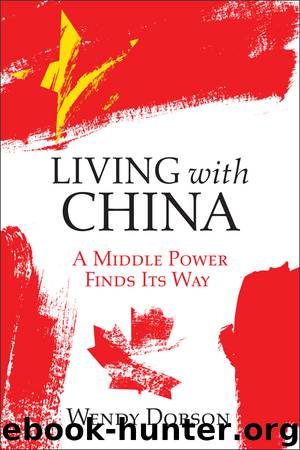Living with China by Wendy Dobson

Author:Wendy Dobson
Language: eng
Format: epub
Tags: LCSH: China – Economic policy – 2000–, LCSH: Canada – Foreign economic relations – China., LCSH: China – Foreign economic relations – Canada.
Publisher: University of Toronto Press
FUTURE ISSUES: SYSTEM DIFFERENCES AND TECHNOLOGY
One key policy implication is that China is becoming a major global source of capital, a trend that will continue but perhaps shift in direction to countries other than the United States. Estimates of the magnitude of China’s outward flows illustrate this point. According to United Nations statistics, in 2017 China’s global stock of outward FDI was $1.48 trillion – the US total was $7.8 trillion – up from just $27 billion in 1999 and equivalent to 12 per cent of China’s GDP.24 If China’s GDP growth were to continue at 6 per cent annual rates and the ratio between outward FDI and GDP remained 12 per cent, by 2020 the total stock of Chinese outward FDI would be more than $1.7 trillion, a 13 per cent increase over 2017. The total might be even larger if the domestic economy grows more slowly and outward investment picks up in search of more global opportunities. Either way, the numbers are large.
Second, host governments that seek to minimize the risks of Chinese mergers and acquisitions while remaining open to the benefits of cross-border investment face substantial differences between the Chinese system and their own, as I recount in Canada’s case in the final chapter. In general, many market participants and analysts argue that some key changes are desirable in China, beginning with a more transparent regime to govern outward FDI. Moves in this direction were announced by the State Council in November 2018, and were included in Chinese commitments in China-US trade and technology talks in early 2019. Achieving this greater transparency, however, would require more robust regulatory capacities to enforce policies and ensure they have the desired effect on investor behaviour.
Political and policy differences also appear in commercial transactions, particularly those with Chinese SOEs, whose decisions might be driven by political, rather than commercial, criteria. This is a particular concern to Canadians. Separating government ownership from enterprise management is a challenge that could be addressed by introducing modern corporate governance practices and applying more stringent transparency requirements to SOEs. Although accounting and external audit practices are gradually becoming more independent, the pace is slow. Financial investors also might have objectives that conflict with national policy objectives – evident in Chinese regulators’ concerns about firms using mergers and acquisitions as a form of capital flight, as hedges against currency devaluation, or in response to the anti-corruption campaign.
Host governments nevertheless should remain open to the net benefits of Chinese investment. Until recently there were relatively few barriers to Chinese FDI in North America or western Europe. Since 1975 the United States has relied on the CFIUS to screen proposed acquisitions for national security concerns. Screening has been reasonably light handed, and few deals have been formally blocked. But rising geopolitical tensions and rivalry are changing this behaviour as the US administration imposes tariffs on a widening range of Chinese goods and China retaliates. Some, perhaps many, Chinese firms are likely to look for alternative investment locations such as
Download
This site does not store any files on its server. We only index and link to content provided by other sites. Please contact the content providers to delete copyright contents if any and email us, we'll remove relevant links or contents immediately.
| Arms Control | Diplomacy |
| Security | Trades & Tariffs |
| Treaties | African |
| Asian | Australian & Oceanian |
| Canadian | Caribbean & Latin American |
| European | Middle Eastern |
| Russian & Former Soviet Union |
The Secret History by Donna Tartt(18767)
The Social Justice Warrior Handbook by Lisa De Pasquale(12087)
Thirteen Reasons Why by Jay Asher(8745)
This Is How You Lose Her by Junot Diaz(6710)
Weapons of Math Destruction by Cathy O'Neil(6090)
Zero to One by Peter Thiel(5643)
Beartown by Fredrik Backman(5556)
The Myth of the Strong Leader by Archie Brown(5380)
The Fire Next Time by James Baldwin(5206)
How Democracies Die by Steven Levitsky & Daniel Ziblatt(5101)
Promise Me, Dad by Joe Biden(5041)
Stone's Rules by Roger Stone(4995)
100 Deadly Skills by Clint Emerson(4806)
A Higher Loyalty: Truth, Lies, and Leadership by James Comey(4803)
Rise and Kill First by Ronen Bergman(4663)
Secrecy World by Jake Bernstein(4599)
The David Icke Guide to the Global Conspiracy (and how to end it) by David Icke(4563)
The Farm by Tom Rob Smith(4409)
The Doomsday Machine by Daniel Ellsberg(4380)
